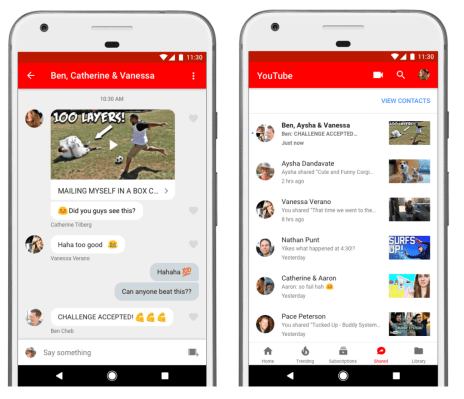YouTube today is launching a new sharing feature in its mobile app, previously in testing with users in select markets. The feature allows YouTube users to send their friends videos and chat from within a new tab in the mobile app – effectively turning YouTube into a mobile messenger of sorts.
The feature has been in testing since the middle of last year, and, at the beginning of 2017, rolled out to users in Canada as something of a “soft launch.” It later expanded to parts of Latin America, the company tells us.
Following the feedback gained from these long-term initial tests, YouTube felt it was ready to debut the sharing feature to a global audience. That roll out begins today, but won’t reach all YouTube users worldwide for a few days. In other words, if you don’t see the sharing option yet – just wait, you will soon.
Since its debut in tests, YouTube says it has made some slight changes to the user interface for sharing, including the way the chat interface appears to users, and it made the video stick to the top of the chat when scrolling down. It also introduced the ability to allow replying and chatting while users are watching a video, which gives the feature more of a real-time feel. However, it hasn’t gone as far as to integrate the emoji responses and co-viewing found in the company’s experimental YouTube app, called YouTube Uptime.
However, YouTube says that more improvements will be rolled out in time.
The idea behind the sharing feature’s development is to transition some of the social activity that takes place around videos – including the sharing of links and chats about the video themselves – back into YouTube instead of other messaging apps. It’s unclear if it will be successful in that regard. People’s preferred mobile messengers already have their established social graphs, and YouTube is having to build its social network of people’s friends and family from scratch.
The feature itself is easy to use – perhaps too easy. While it allows you to find friends from your phone’s Address Book, there’s currently no way to block requests from those you don’t know. You can, of course, deny those requests, but for public figures or those whose name or contact information is more freely available, this can be a problem. I had access to the feature while in testing, and found that I had a slew of incoming requests from strangers, for example – and this was before the public launch.
In addition to sharing videos and chatting, YouTube users can also reply to videos they receive with other videos, or even a heart. Group sharing with up to 30 people is supported, too.
The feature is making its way to YouTube on both iOS and Android, to users worldwide.
